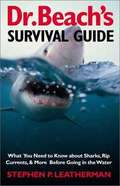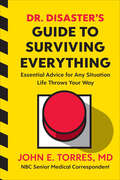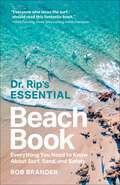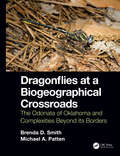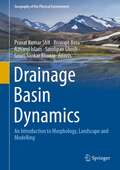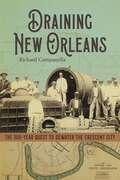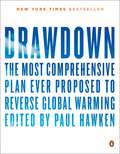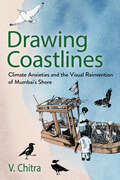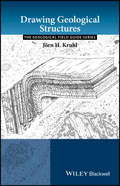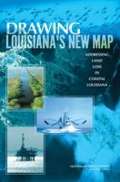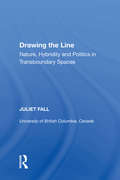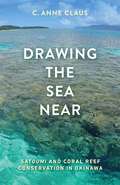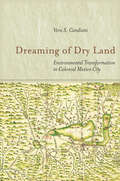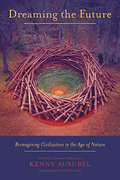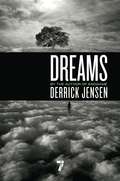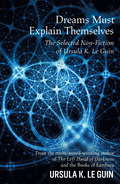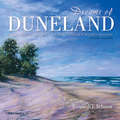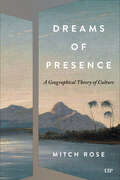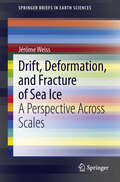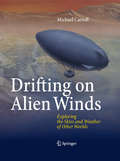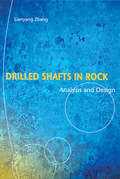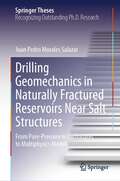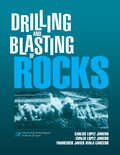- Table View
- List View
Dr. Beach's Survival Guide: What You Need to Know about Sharks, Rip Currents, and More Before Going in the Water
by Stephen P. LeathermanHere, from the nation's most renowned beach expert, is the first complete guide to beach safety. Stephen P. Leatherman (a. k. a. Dr. Beach) introduces the gamut of beach hazards - from sharks to rip currents to jellyfish - revealing which dangers should be of greatest concern and how best to minimize their risks. His scientifically sound advice, interspersed with fascinating facts and anecdotes, makes this book a perfect reference for the millions of travelers and vacationers who visit the ocean shore every year. --BOOK JACKET. Title Summary field provided by Blackwell North America, Inc. All Rights Reserved
Dr. Disaster's Guide to Surviving Everything: Essential Advice for Any Situation Life Throws Your Way
by John E. TorresFrom an ER doctor and Special Forces instructor, an all-encompassing guide to preparing for disasters both natural and man-made. An emergency room physician and U.S. Air Force veteran, Dr. John Torres, aka “Dr. Disaster,” has spent his career on the front lines, saving lives in all sorts of disasters. From treating trauma patients to serving in rescue missions in Antarctica to covering the country’s latest crisis as an NBC senior medical correspondent, his entire job is to think about best practices in emergencies—and now he’s sharing his hard-won knowledge.Dr. Torres provides essential advice for surviving worst-case scenarios from natural disasters like lightning strikes, hurricanes, and wildlife encounters to human-made ones like terrorist attacks and active-shooter situations. Engrossing and informative, this book is full of hacks that could save your life, such as:How to prep your home for any emergencyWhy you should never use a landline during a thunderstormThe safest place to sit on an airplaneWhat to do during civil unrest or cyberattacksWhat to pack in a “bug-out bag”How to start a fire with common household itemsThe first thing you should do every time you enter a shopping mallAlso included is a chapter on how to teach kids to be alert and prepared—without freaking them out. Organized by topic, this is a valuable guide to protecting yourself and your loved ones in an unpredictable world.
Dr. Rip's Essential Beach Book: Everything You Need to Know About Surf, Sand, and Safety
by Rob BranderHow do waves break, and what makes good surf? What are dangerous rip currents, and how do you spot one? What should you do if you get caught in one?Australia’s best-known surf scientist, Rob “Dr. Rip” Brander, takes readers on a fascinating and entertaining journey to uncover how beaches form and behave, the science of waves and currents, and how beaches respond to storms and climate change. He explains where the sand we lay our towels on came from, how the tides that wash up new treasures each day work, why no two beaches are exactly the same, and why some of them are disappearing. He also explores some of the hazards to watch out for, from rip currents to tsunamis to the (unlikely) event you find yourself swimming with a shark.Whether you’re a surfer looking for the perfect wave or you just enjoy hitting the beach with friends and family, this book is a must-read for all ocean lovers.
Drafting a Conservation Blueprint: A Practitioner's Guide To Planning For Biodiversity
by Malcolm Hunter Malcolm The Nature Conservancy Craig GrovesDrafting a Conservation Blueprint lays out for the first time in book form a step-by-step planning process for conserving the biological diversity of entire regions. In an engaging and accessible style, the author explains how to develop a regional conservation plan and offers experience-based guidance that brings together relevant information from the fields of ecology, conservation biology, planning, and policy. Individual chapters outline and discuss the main steps of the planning process, including:* an overview of the planning framework * selecting conservation targets and setting goals * assessing existing conservation areas and filling information gaps * assessing population viability and ecological integrity * selecting and designing a portfolio of conservation areas * assessing threats and setting priorities A concluding section offers advice on turning conservation plans into action, along with specific examples from around the world.The book brings together a wide range of information about conservation planning that is grounded in both a strong scientific foundation and in the realities of implementation.
Dragonflies at a Biogeographical Crossroads: The Odonata of Oklahoma and Complexities Beyond Its Borders
by Brenda D. Smith Michael A. PattenThis lavishly illustrated book examines the distribution, ecology, conservation status, and biogeography of 176 species of dragonflies in the southern plains of the United States, where twelve ecoregions converge. The topics discussed, such as phenotypic variation and ecology, are applicable and of interest across the United States and much of north America, and will appeal to researchers and dragonfly enthusiasts alike. A series of maps, including a distributional map by specific locality of occurrence, indicate level of documentation and allow the reader to visualize the biogeographical associations of a given species. These maps also encourage citizen scientists to contribute documentation wherever they spend time in the field. Context-driven chapters, including one on the region’s rich paleontological history, blend environmental history and biogeography, giving the book a fresh perspective on the natural world while providing a rich summary of the odonates. Dragonflies at a Biographical Crossroads: The Odonata of Oklahoma and Complexities Beyond Its Borders will be sought out by dragonfly researchers and enthusiasts, entomologists, amateur naturalists, paleontologists, conservation biologists, educators, regional historians, and those seeking to meld the disciplines of cultural and environmental history with biology. It will also be readily accessible to the lay public. Dragonflies combine the visually stunning with acrobatic fireworks in ways no other insect can hope to combine.
Drainage Basin Dynamics: An Introduction to Morphology, Landscape and Modelling (Geography of the Physical Environment)
by Sandipan Ghosh Aznarul Islam Gouri Sankar Bhunia Pravat Kumar Shit Biswajit BeraThis volume provides a versatile introduction to the study of drainage basin evolution, morphology, drainage basin hydrology and sedimentology, human interference, natural and anthropogenic hazards and various management techniques. This book offers the responsible factors of sediment yield and their absolute and specific growth and rate of delivery through tributaries to the main streams. Rivers are important geomorphic agents which reflect an amazing variety of form and behaviour, showing the wide range of natural environment in which they are originated. The drainage system evolution and spatial network development within the dynamic nature are being discussed and how they are adjusted in the geomorphic time scale over the millions of years. This book shows how drainage systems function and react to change and why this thoughtful is required for flourishing integrated basin management. In tropical and sub-tropical countries population pressures as well as different developmental projects are being executed on the drainage basin without proper planning. Today scientists consider drainage basin as an administrative unit during implementation of regional projects. In this context this book will carry a bench mark for scholars and young scientists.
Draining New Orleans: The 300-Year Quest to Dewater the Crescent City
by Richard CampanellaIn Draining New Orleans, the first full-length book devoted to “the world’s toughest drainage problem,” renowned geographer Richard Campanella recounts the epic challenges and ingenious efforts to dewater the Crescent City. With forays into geography, public health, engineering, architecture, politics, sociology, race relations, and disaster response, he chronicles the herculean attempts to “reclaim” the city’s swamps and marshes and install subsurface drainage for massive urban expansion.The study begins with a vivid description of a festive event on Mardi Gras weekend 1915, which attracted an entourage of elite New Orleanians to the edge of Bayou Barataria to witness the christening of giant water pumps. President Woodrow Wilson, connected via phoneline from the White House, planned to activate the station with the push of a button, effectively draining the West Bank of New Orleans. What transpired in the years and decades that followed can only be understood by examining the large swath of history dating back two centuries earlier—to the geological formation and indigenous occupation of this delta—and extending through the colonial, antebellum, postbellum, and Progressive eras to modern times. The consequences of dewatering New Orleans proved both triumphant and tragic. The city’s engineering prowess transformed it into a world leader in drainage technology, yet the municipality also fell victim to its own success. Rather than a story about mud and machinery, this is a history of people, power, and the making of place. Campanella emphasizes the role of determined and sometimes unsavory individuals who spearheaded projects to separate water from dirt, creating lucrative opportunities in the process not only for the community but also for themselves.
Draw Along Animals: Sketch Your Way Through the Animal Kingdom
by Pippa PixleyLearn how to draw all of your favorite animals with help from artist, Pippa PixleyJoin author and artist, Pippa Pixley, as she teaches you how to draw animals of all shapes and sizes. All animals are shown in a simple step-by-step format so budding artists can follow along with ease, while adding their own artistic flair and personal touches.This book will inspire creativity and resourcefulness with pages on how to make and use your very own inks. Learn about techniques such as mark-making, mixing colors, and shading to create texture and add depth to drawings. Go wild and experiment with different materials like charcoal and graphite, and let your imagination run free across the page.This learn-to-draw book features:A collection of cute animals to draw in all different shapes and sizes.Simple draw-along steps that are straightforward and sketchy, making it easy for children to follow along.Tips on how to use different natural materials and techniques to improve their skills.With Pippa Pixley’s Draw Along, little ones will be creating masterpieces in no time! From cheeky chickens to sleepy sloths, and brilliant bugs to little lambs, whatever your favorite animal is, Pippa can teach you how to draw it! Perfect for young artists of all ages, whether learning to draw for the first time or refining more advanced skills, this book has something for everyone. Inspire imagination and spark a journey of creativity and artistry that will last for years to come.
Drawdown: The Most Comprehensive Plan Ever Proposed to Reverse Global Warming
by Edited by Paul Hawken• New York Times bestseller •The 100 most substantive solutions to reverse global warming, based on meticulous research by leading scientists and policymakers around the world&“At this point in time, the Drawdown book is exactly what is needed; a credible, conservative solution-by-solution narrative that we can do it. Reading it is an effective inoculation against the widespread perception of doom that humanity cannot and will not solve the climate crisis. Reported by-effects include increased determination and a sense of grounded hope.&” —Per Espen Stoknes, Author, What We Think About When We Try Not To Think About Global Warming &“There&’s been no real way for ordinary people to get an understanding of what they can do and what impact it can have. There remains no single, comprehensive, reliable compendium of carbon-reduction solutions across sectors. At least until now. . . . The public is hungry for this kind of practical wisdom.&” —David Roberts, Vox&“This is the ideal environmental sciences textbook—only it is too interesting and inspiring to be called a textbook.&” —Peter Kareiva, Director of the Institute of the Environment and Sustainability, UCLAIn the face of widespread fear and apathy, an international coalition of researchers, professionals, and scientists have come together to offer a set of realistic and bold solutions to climate change. One hundred techniques and practices are described here—some are well known; some you may have never heard of. They range from clean energy to educating girls in lower-income countries to land use practices that pull carbon out of the air. The solutions exist, are economically viable, and communities throughout the world are currently enacting them with skill and determination. If deployed collectively on a global scale over the next thirty years, they represent a credible path forward, not just to slow the earth&’s warming but to reach drawdown, that point in time when greenhouse gases in the atmosphere peak and begin to decline. These measures promise cascading benefits to human health, security, prosperity, and well-being—giving us every reason to see this planetary crisis as an opportunity to create a just and livable world.
Drawing Coastlines: Climate Anxieties and the Visual Reinvention of Mumbai's Shore (Expertise: Cultures and Technologies of Knowledge)
by V. ChitraDrawing Coastlines reveals the ways that technical images such as weather infographics, sea-level projections, and surveys are fast remaking Mumbai's coasts and coastal futures. They set in place infrastructural interventions, vocabularies of development and conservation, and their lines and dots inscribe material conditions of existence and horizons of loss that entangle life forms. V. Chitra interlaces graphics and text by redrawing scientific images, the moments of their construction, the choices and consequences of what gets drawn and what does not, and how images are seen, performed, and manifest. These visual reconstructions show how images remake human-nonhuman relationships, arrange urban politics, and materialize landscapes in complex and contradictory ways. The multimodal format of Drawing Coastlines engages in the politics of its context where words and images combine to create coastal worlds, and to find, through a creative anthropology, openings to build new forms of care in the midst of crisis.
Drawing Geological Structures (Geological Field Guide)
by Jörn H. KruhlDespite the modern dominance of computer graphics programs and digital cameras, the ability todraw geological structures manually remains a necessity in academic geology and beyond. Drawings serve for quick and simple documentation in the field or at the microscope. They can be applied as a language of their own as well as be adapted to suit specific requirements. Moreover, geological drawing improves observational ability and contributes to the understanding of geological structures and structure-forming processes. Geological drawing is assisted scientific thinking. Drawing Geological Structures provides undergraduate as well as graduate and practicing geologists with a thorough, step-by-step practical guide to the art of geological drawing. Beginning with the basics, the book covers thin sections, sample sections, samples and geological stereograms. The chapters provide examples of how drawings evolve and are complemented by exercises, allowing the reader to practice their drawing prior to going out into the field or working at the microscope. Users of this unique guide will develop their knowledge and technical vocabulary whilst also improving their drawing skills.
Drawing Louisiana's New Map: Addressing Land Loss In Coastal Louisiana
by National Research Council of the National AcademiesDuring the past 50 years, coastal Louisiana has suffered catastrophic land loss due to both natural and human causes. This loss has increased storm vulnerability and amplified risks to lives, property, and economies--a fact underscored by Hurricanes Katrina and Rita. Drawing Louisiana's New Map reviews a restoration plan proposed by the U.S. Army Corps of Engineers and the State of Louisiana, finding that, although the individual projects in the study are scientifically sound, there should be more and larger scale projects that provide a comprehensive approach to addressing land loss over such a large area. More importantly, the study should be guided by a detailed map of the expected future landscape of coastal Louisiana that is developed from agreed upon goals for the region and the nation.
Drawing the Line: Nature, Hybridity and Politics in Transboundary Spaces (Border Regions Ser.)
by Juliet FallThis book provides the first comprehensive and critical examination of the spatial assumptions underpinning transboundary protected areas in Europe, at a time of surging global enthusiasm in creating and managing such areas. It explores how the reliance on the natural science approach to space within environmental planning has led to a return of exclusionary discourses, in paradoxical contrast to the stated claims of designing 'peace parks'. The book builds a much-needed link between the critical geopolitical literature on boundaries and social approaches to nature and hybridity. Drawing the Line is theoretically informed yet grounded in substantial fieldwork from sites in France, Germany, Italy, Poland, Romania, Slovakia and the Ukraine. It uses material from the field to build and question theoretical debates, moving beyond site-specific issues to wider patterns and trends.
Drawing the Sea Near: Satoumi and Coral Reef Conservation in Okinawa
by C. Anne ClausHow Japanese coastal residents and transnational conservationists collaborated to foster relationships between humans and sea life Drawing the Sea Near opens a new window to our understanding of transnational conservation by investigating projects in Okinawa shaped by a &“conservation-near&” approach—which draws on the senses, the body, and memory to collapse the distance between people and their surroundings and to foster collaboration and equity between coastal residents and transnational conservation organizations. This approach contrasts with the traditional Western &“conservation-far&” model premised on the separation of humans from the environment.Based on twenty months of participant observation and interviews, this richly detailed, engagingly written ethnography focuses on Okinawa&’s coral reefs to explore an unusually inclusive, experiential, and socially just approach to conservation. In doing so, C. Anne Claus challenges orthodox assumptions about nature, wilderness, and the future of environmentalism within transnational organizations. She provides a compelling look at how transnational conservation organizations—in this case a field office of the World Wide Fund for Nature in Okinawa—negotiate institutional expectations for conservation with localized approaches to caring for ocean life. In pursuing how particular projects off the coast of Japan unfolded, Drawing the Sea Near illuminates the real challenges and possibilities of work within the multifaceted transnational structures of global conservation organizations. Uniquely, it focuses on the conservationists themselves: why and how has their approach to project work changed, and how have they themselves been transformed in the process?
Dreaming of Dry Land: Environmental Transformation in Colonial Mexico City
by Vera S. CandianiNot long after the conquest, the City of Mexico's rise to become the crown jewel in the Spanish empire was compromised by the lakes that surrounded it. Their increasing propensity to overflow destroyed wealth and alarmed urban elites, who responded with what would become the most transformative and protracted drainage project in the early modern America—the Desagüe de Huehuetoca. Hundreds of technicians, thousands of indigenous workers, and millions of pesos were marshaled to realize a complex system of canals, tunnels, dams, floodgates, and reservoirs. Vera S. Candiani's Dreaming of Dry Land weaves a narrative that describes what colonization was and looked like on the ground, and how it affected land, water, biota, humans, and the relationship among them, to explain the origins of our built and unbuilt landscapes. Connecting multiple historiographical traditions—history of science and technology, environmental history, social history, and Atlantic history—Candiani proposes that colonization was a class, not an ethnic or nation-based phenomenon, occurring simultaneously on both sides of an Atlantic, where state-building and empire-building were intertwined.
Dreaming the Future: Reimagining Civilization in the Age of Nature
by Kenny Ausubel David W. OrrFew would deny that we are entering a period of great change. Our environment is collapsing. Social disruption abounds. All around, it seems, we are experiencing breakdown. But out of this chaos comes the opportunity for breakthrough-the opportunity to reimagine our future. In Dreaming the Future, Kenny Ausubel leads us into that possible new world and introduces us to the thinkers and doers who are-sometimes quietly, sometimes not-leading what he calls "a revolution from the heart of nature and the human heart." In a collection of short, witty, poignant, even humorous essays, Ausubel tracks the big ideas, emerging trends, and game-changing developments of our time. He guides us through our watershed moment, showing how it's possible to emerge from a world where corporations are citizens, the gap between rich and poor is cavernous, and biodiversity and the climate are under assault and create a world where we take our cues from nature and focus on justice, equity, diversity, democracy, and peace. Even those steeped in the realities of a world gone wrong and efforts to right it will find refreshing, even surprising, perspectives in Dreaming the Future. It will come as no surprise to readers that Ausubel is cofounder of Bioneers-which foreword author David W. Orr describes as "one part global salon...one part catalytic organization."
Dreams
by Derrick JensenJensen's furthest-reaching book yet, Dreams challenges the "destructive nihilism" of writers like Richard Dawkins and Sam Harris who believe that there is no reality outside what can be measured using the tools of science. He introduces the mythologies of ancient cultures and modern indigenous peoples as evidence of alternative ways of understanding reality, informed by thinkers such as American Indian writer Jack Forbes, theologian and American Indian rights activist Vine Deloria, Shaman Martin Prechtel, Dakota activist and scholar Waziyatawin, and Okanagan Indian writer Jeannette Armstrong. He draws on the wisdom of Dr. Paul Staments, author of Mycelium Running: How Mushrooms Can Help Save the World, sociologist Stanley Aronowitz, who discusses science's lack of accountability to the earth, and many more. As in his other books, Jensen draws heavily from his own life experience living alongside the frogs, redwoods, snails, birds and bears of the upper northwest, about which he writes with exquisite tenderness.Having taken on the daunting task of understanding one's dreams as a source of knowledge, Jensen achieves the near-impossible in this breathtakingly brave and ambitious new work.
Dreams Must Explain Themselves: The Selected Non-Fiction of Ursula K. Le Guin
by Ursula K. Le Guin'By turns sharp, funny and insightful, high-minded but never mean-spirited, the book embodies its author's lifelong quest for freedom: freedom as a woman, freedom to write what she pleased, freedom to like what she liked. Genre fiction - and literature in general - has lost not just one of its brightest exponents but one of its bolshiest champions.' FINANCIAL TIMES'Excellent' CHOICE'Le Guin is one of the singular speculative voices of our future, thanks to her knack for anticipating issues of seminal importance to society' TLSUrsula K. Le Guin has won or been nominated for over 200 awards for her fiction, including the Hugo, Nebula, World Fantasy and SFWA Grand Master Awards. She is the acclaimed author of the Earthsea sequence and The Left Hand of Darkness - which alone would qualify her for literary immortality - as well as a remarkable body of short fiction, including the powerful, Hugo-winning 'The Ones Who Walk Away from Omelas' and the masterpiece of anthropological and environmental SF 'The Word for World is Forest' - winner of the Hugo Award for best novella. But Ursula Le Guin's talents do not stop at fiction. Over the course of her extraordinary career, she has penned numerous essays around themes important to her: anthropology, environmentalism, feminism, social justice and literary criticism to name a few. She has responded in detail to criticism of her own work and even reassessed that work in the context of such critiques. This selection of the best of Le Guin's non-fiction shows an agile mind, an unparalleled imagination and a ferocious passion to argue against injustice. In 2014 Ursula Le Guin was awarded the National Book Foundation's Medal for Distinguished Contribution to American Letters, and her widely praised acceptance speech is one of the highlights of this volume, which shows that one of modern literature's most original voices is also one of its purest consciences.
Dreams of Duneland: A Pictorial History of the Indiana Dunes Region
by Kenneth J. SchoonThe towering sand dunes along Lake Michigan, not far from Chicago, are one of the most unexpected natural features of Indiana.The second edition of Dreams of Duneland beautifully illustrates the dunes region, from the past to the present. Since the first edition, the Indiana Dunes area has become an official national park. With more than 400 stunning images, many of them new, Dreams of Duneland showcases the breathtaking sand dunes, as well as the rest of this newly minted park, which includes savanna, wetland, prairie, and forest and is home to a wide variety of plant and animal species. Kenneth J. Schoon reveals how the preserved area of the Indiana Dunes National Park—which sits by residential communities, businesses, and cultural attractions—has a long history of competition among farmers, fur traders, industrialists, and conservationists. Featuring a new foreword and afterword and many updates throughout, this gorgeous new edition will have you planning a trip to the extraordinary Indiana Dunes.
Dreams of Presence: A Geographical Theory of Culture
by Mitch RoseThroughout the twentieth century, the question of culture was a central pillar of social scientific thought. Today, however, the concept has disappeared from the academic landscape. Despite pressing political debates about culture wars, identity politics, cultural appropriation, and nativism, the concept of culture is no longer seen as a credible explanatory tool. Dreams of Presence provides a novel theoretical approach to the question of culture and will be of use to geographers, anthropologists, sociologists, and social theorists grappling to understand why culture continues to be a dominant political force in our contemporary world. Drawing on Heidegger, Levinas, Derrida, and Žižek, Mitch Rose provides an existential, rather than sociological, account of culture, conceptualizing it as a refuge where subjects endeavour to establish ownership over a life that perpetually eludes them. The book argues that culture is a claim; not something subjects ever have but something they desire; not something properly present but a dream of presence: an imagination of identity we cultivate, care for, and materially build in order to assure ourselves that we are sovereign, self-standing beings.
Drift, Deformation, and Fracture of Sea Ice
by Jérôme WeissSea ice is a major component of polar environments, especially in the Arctic where it covers the entire Arctic Ocean throughout most of the year. However, in the context of climate change, the Arctic sea ice cover has been declining significantly over the last decades, either in terms of its concentration or thickness. The sea ice cover evolution and climate change are strongly coupled through the albedo positive feedback, thus possibly explaining the Arctic amplification of climate warming. In addition to thermodynamics, sea ice kinematics (drift, deformation) appears as an essential factor in the evolution of the ice cover through a reduction of the average ice age (and consequently of the cover's thickness), or ice export out of the Arctic. This is a first motivation for a better understanding of the kinematical and mechanical processes of sea ice. A more upstream, theoretical motivation is a better understanding of the brittle deformation of geophysical objects across a wide range of scales. Indeed, owing to its very strong kinematics, compared e.g. to the Earth's crust, an unrivaled kinematical data set is available for sea ice from in situ (e.g. drifting buoys) or satellite observations. Here, we review the recent advances in the understanding of sea ice drift, deformation and fracturing obtained from these data. We focus particularly on the scaling properties in time and scale that characterize these processes, and we emphasize the analogies that can be drawn from the deformation of the Earth's crust. These scaling properties, which are the signature of long-range elastic interactions within the cover, constrain future developments in the modeling of sea ice mechanics. We also show that kinematical and rheological variables such as average velocity, average strain-rate or strength have significantly changed over the last decades, accompanying and actually accelerating the Arctic sea ice decline.
Drifting on Alien Winds
by Michael CarrollEver since the Montgolfier's hot air balloon carried a chicken, a goat, and a duck into the Parisian skies, scientists have dreamed of contraptions to explore the atmosphere. With the advent of the space age, new airborne inventions were needed. From the Soviet Venus balloons to the advanced studies of blimps and airplanes for the atmospheres of Mars and Titan, Drifting on Alien Winds surveys the many creative and often wacky ideas for exploring alien skies. Through historical photographs and stunning original paintings by the author, readers also explore the weather on planets and moons, from the simmering acid-laden winds of Venus to liquid methane-soaked skies of Titan.
Drilled Shafts in Rock: Analysis and Design
by Lianyang ZhangDrilled shafts in rock are widely used as foundations of heavy structures such as highway bridges and tall buildings. Although much has been learned about the analysis and design of drilled shafts in rock, all the major findings are published in the form of reports and articles in technical journals and conference proceedings. This book i
Drilling Geomechanics in Naturally Fractured Reservoirs Near Salt Structures: From Pore-Pressure in Carbonates to Multiphysics Models (Springer Theses)
by Juan Pedro Morales SalazarThis book explains different phenomena that occur in Naturally Fractured Reservoirs (NFRs) of carbonate rocks neighboring a salt structure and how it affects well drilling. Prediction of carbonate pore pressure is difficult; therefore, a new set of pore pressure equations for carbonates were developed, accounting for overpressure and depleted conditions. A detailed description of a fully coupled model is shown in order to discuss geomechanics and the coupling of fluid flow in porous media and to achieve a better representation of the mechanics involved in the exploitation of NFRs. Additionally, results of a new model of geomechanics in vuggy carbonate reservoirs are presented. This book also displays a wide discussion, analysis, and numerical implementation of six different salt rheology models. Furthermore, the most representative rheology salt models were studied aside with the fully coupled model of geomechanics and fluid flow in porous media. Finally, it presents an answer to areal case of a well drilled near a salt diapir where anomalous pore pressure was found.
Drilling and Blasting of Rocks
by FranciscoJavier AyalaCarcedoRock breakage with explosives has existed since the seventeenth century when black powder came into use in mining. Since then it has progressed from the invention of dynamite to the use of heavy ANFO. During the past two decades, there have been numerous technical contributions which have brought a better understanding of rock fragmentation with explosives, an improvement in drilling equipment and a noticeable evolution in the development of new explosives and blasting accessories. The Geomining Technological Institute of Spain (ITCE), aware of this progress and of the importance which the breakage process has acquired in mining and civil engineering projects, has ordered the publication of Drilling and Blasting of Rocks. The purpose of this Handbook is to give basic knowledge of the drilling systems, the types of available explosives and the accessories and the parameters that intervene in blast designing, whether controllable or not; at the same time the objectives and contents contribute to improved safety in mining. The Handbook is meant for all professionals who are involved with explosives in mining operations and civil engineering projects, as well as for students of technical schools.
